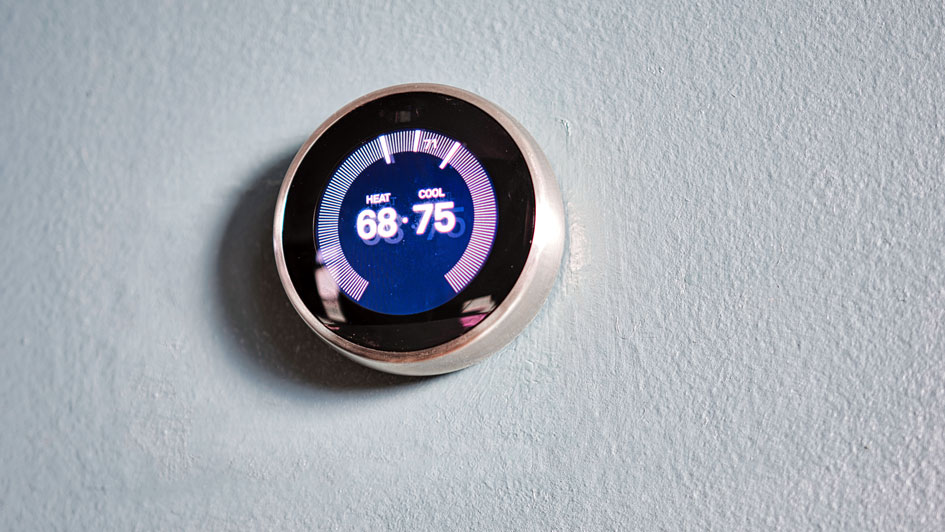
A Nest Thermostat is an excellent tool for keeping your home comfortable, regardless of the season or weather. With a number of innovative features meant to maximize efficiency, convenience and comfort, a Nest Thermostat is an easy way to manage your energy use — keeping costs down in the process.
That’s why more homeowners are considering adding devices like a Nest to their homes. If you're interested in trying a Nest yourself, call your nearest expert for smart thermostat installation in Wisconsin Rapids.
From auto scheduling to optimizing energy efficiency, Nest helps make home climate control effortless.
Ready to learn more? Here’s a look at 12 things you should know about your Nest Thermostat.
1. How to Reset a Nest Thermostat
The first thing to know about resetting a Google Nest Thermostat is that there's a difference between a restart and a reset.
- Restart: A common feature in consumer electronics, including your phone or computer, restarting your Nest Thermostat simply turns it off and then back on. This preserves current settings and should be attempted if your Nest is frozen or not connecting to Wi-Fi.
- Reset: A reset erases some or all of your settings. People normally only use a reset when they’re moving to a new home and bringing the thermostat with them, or if they're moving out and prefer to erase all personal info from the Nest before leaving it for the next homeowner.
If you want to perform a reset, it doesn't hurt to write down current temperature settings so reapplying them is faster. Next, locate Settings -> Equipment and record your system wires, heating type and safety temperature settings.
After writing down this information, go to Settings, select Reset and press. You will then have five options:
- Restart: Deactivates your Nest and starts it back up while remembering your settings. Another method is to press the outside of the Nest and hold it down for a few seconds until it goes black, at which point you can remove your hand.
- Schedule: This reset clears any info about your temperature schedule—including for your hot water, if you have that programmed into your Nest. With this option, you’ll need to create a new schedule or wait while your Nest learns your schedule.
- Away: An Away reset removes anything your Nest has learned about how often you walk by, so that it can change the temperature accordingly.
- Network: With a network reset, it erases connection info and your Nest will no longer be connected to Wi-Fi. It also forgets your Wi-Fi password.
- All Settings: This reset clears all your personal settings and learning.
2. How to Connect Nest Thermostat to Wi-Fi
Connecting to Wi-Fi is important for making the most of your Nest's features.
To connect your Nest to the internet:
- Open the Quick View menu by turning the thermostat ring.
- Find the Settings icon.
- Press Network.
- After your Nest is finished scanning for local networks, locate your Wi-Fi and, if you have one, enter your password.
3. Does a Nest Thermostat Use a Battery and How Long Will the Battery Last?
Nest thermostats get the power they need directly from your HVAC system, but each one also features a rechargeable lithium-ion battery for backup power in case of an outage. According to Google, who manufactures the thermostat, a Nest Thermostat battery should last several months. Recharge it with the USB cord that comes included.
4. Shutting Off a Nest Thermostat
If you plan on being away for a couple weeks, it's a good idea to set your Nest Thermostat to Off mode, though Eco mode is also a good option. The Off mode option deactivates your regular heating and cooling schedules, while maintaining existing Safety Temperatures to keep your home from getting especially hot or cold.
To find Off mode on the thermostat:
- Press and hold the touch bar until it displays “Turn Off” before sliding the bar to highlight Turn Off, and then touch the bar to select.
- Or, from the main menu, go to Mode and select Off.
Off mode can even be accessed from your Google Home app:
- Select Thermostat from home screen
- Tap Temperature mode
- Select Off
5. Can Alexa Control a Nest Thermostat?
Yes, your Amazon Alexa can be used to control a Nest Thermostat. Alexa can also be integrated with with Nest doorbells and cameras. You can even operate a Nest Thermostat with Google Assistant.
6. Can a Nest Thermostat Work Without Wi-Fi?
In short, yes. Your Nest Thermostat can control the temperature of your home without Wi-Fi. That being said, a lack of an internet connection means your Nest doesn’t have the smart thermostat functions that most people enjoy.
7. Are You Able to Lock a Nest Thermostat?
If you’re having a battle over the thermostat in your home between people who like things hot and others who prefer them cold, Nest has a function to give you the upper hand.
Nest has a locking feature that allows a user to stop any temperature adjustments outside of a preset range. This doesn’t lock in a specific temperature—a locked Nest still has access to programmed settings—but simply prevents people from changing the settings.
If you want to lock your Nest:
- Press the Settings icon, scroll to the bottom and locate the function listed as Lock.
- Enter a 4-digit pin number you can remember, and then enter it twice.
- For locking a Nest in Heat or Cool mode, select your maximum and minimum temperature range and then press Lock at the bottom of the screen.
For unlocking it, open the settings and choose Unlock. As soon as you've provided your 4-digit pin, the Nest will be unlocked.
8. How to Control a Nest Thermostat from Your Phone
You can control the Nest through your Google Home app, which is accessible on your phone as well as a computer. Other versions of Nest, including the Nest Thermostat E and Nest Learning Thermostat, are also controllable through the Nest app.
Before you can make adjustments for a Nest on your phone with Google Home or the Nest app, there are a few steps to complete first:
- Download the Google Home app or, with premium Nest models, the Nest app to your phone.
- Connect your Nest Thermostat.
- Start the Google Home app on your phone and select the account, link to your new device and connect to Wi-Fi.
- There is a guided setup tool on Google, if you prefer additional assistance in connecting.
As soon as you've connected the Nest to your Home app, you can find and adjust it by clicking Thermostat on the home screen. Once you do that, you can change your Nest temperature by dragging your finger along the screen or tapping on a plus or minus sign.
You also can change preset Nest temperatures on the app. From the home screen, find your Thermostat before selecting Settings. Once there, press Temperature Preferences and then Temperature Presets. This will display your preset Comfort, Eco and Sleep temperatures. Choose the appropriate setting to change the temperature for that preset.
9. Creating a Nest Thermostat Schedule
Your Nest allows you to schedule temperature programming either on the device or on the Google Home app. More advanced versions of the Nest, such as the Nest Thermostat E and Nest Learning Thermostat, can also be adjusted by using the Nest app.
You have two primary ways to establish a temperature schedule on a Nest Thermostat:
- Quick Schedule: Quick Schedules are based on the national average schedule for energy efficiency. As you set the thermostat up, the Google Home app allows you to change the temperature with a schedule. If you choose that option, it will show a preset schedule and allows you to make changes. After you've made all your choices, that’s the schedule it will use.
- Temperature Presets: If you prefer other basic preset options, open the Google Home app and press Thermostat. Then, tap Presets and select Edit. As soon as you're finished making updates, select Done.
If you already have a schedule and want to change it, open the Google Home app, select Thermostat and then tap on Schedules. You can then pick the day of the week that you want to add a temperature. Once you pick the day, tap Add and find the preset you want. Finally, select Time before touching and dragging the numbers to change the time. Your update won't be applied until you select Done.
10. How to Set a Temperature Range on a Nest Thermostat
You can set a temperature range on a Nest Thermostat in the Eco mode. A key part of this feature is the Nest's ability to adjust the temperature based on whether it detects you at home or not.
To access Eco mode for customized temperature ranges, go to Settings and select Eco. That should display the current “Heat to” and “Cool to” temperature settings. You can select each and adjust them to your desired temperature. Once you're finished, select Done.
11. What Should I Do If My Nest Thermostat Isn't Compatible?
Nest thermostats can be integrated with most HVAC systems. The maker of Nest, Google, features a compatibility checking tool that presents a few questions related to your location and existing setup to learn which Nest model works with your system.
If you don't think your Nest is compatible with your system, you should get in touch with local pros for smart thermostat installation in Wisconsin Rapids. An experienced technician will be able to evaluate your system and, if your Nest is compatible, install it quick so you can jump right into the savings and convenience.
12. Can I Manually Control My Nest Thermostat?
Nest Thermostats are packed with features designed to increase comfort and decrease costs. However, you have the ability to turn off the smart features if you prefer manual controls similar to normal thermostats.
Don't forget, by doing this you're eliminating your temperature schedules and letting the Nest work like any other thermostat—it will display the temperature and let you change the temperature, but that’s about it.
You can achieve this by disabling the settings in a series of steps:
- Auto-Schedule: From the main screen, go to Settings and then scroll to Nest Sense. Go to Auto-Schedule, select No and click Done.
- Eco: From the main screen, go to Settings, scroll to Eco. Once in Eco, select Off for both the current Heat to and Cool to temperatures, before selecting Done.
- Home/Away Assist: From the main screen, go to Settings and select Home/Away Assist. Then, select Stop Using and click Done.
- Reset: Once you’ve turned off the settings, reset your nest. From the main screen, go to Settings and select Reset, highlight Schedule and then select Reset to clear out any saved scheduling data.
